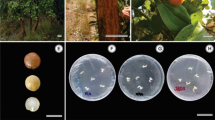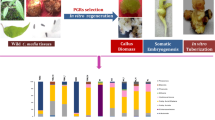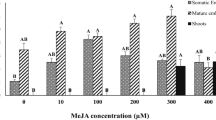Abstract
Ceropegia karulensis is an endemic and critically endangered plant of the Western Ghats from India. Exploitation of the tubers and poor regeneration from seed has narrowed distribution and propagation of the species. There is a need to develop in vitro propagation methods for C. karulensis to alleviate these problems. Here, we optimized callus induction, somatic embryogenesis and microtuberization from different seedling explants viz. cotyledonary leaf and root. The environmental scanning electron microscopy was used to observe somatic embryonic origin and their developmental stages. Highest callus proliferation was recorded with 2 µM 6-benzylaminopurine and 1 µM 2,4-dichlorophenoxyacetic acid. Somatic embryos derived from cotyledonary leaf explants were more proliferative than root explants. The combination of 2 µM 6-benzylaminopurine, 2 µM naphthalene acetic acid and 7% sucrose in MS media resulted in highest microtuberization. Further, gas chromatography-mass spectrometry based metabolic profiling was carried out from native wild plants and in vitro callus tissues which identified various phytochemicals such as alkaloids, fatty acids, esters alcohols, etc. Multivariate analysis revealed the chemical disparities, where considerable variations were observed between native wild type and in vitro tissues, but no significant differences were found among in vitro callus from both root and cotyledonary explants. Overall, our results suggested that the production of various secondary metabolites found in C. karulensis was not affected by in vitro propagation and could be utilized in the conservation strategies for this plant.
Graphical Abstract







Similar content being viewed by others
Abbreviations
- BAP:
-
6-benzylaminopurine
- 2,4-D:
-
2,4-dichlorophenoxyacetic acid
- NAA:
-
Naphthalene acetic acid
- MS:
-
Murashige and Skoog’s medium
- PGR(s):
-
Plant growth regulator(s)
- HF:
-
Hormone-free
- SEs:
-
Somatic embryos
- ESEM:
-
Environmental scanning electron microscopy
- GC-MS:
-
Gas chromatography-mass spectrometry
- GC-FID:
-
Gas chromatography-flame ioinzation detector
- CAL:
-
Central National Herbarium
References
Adibatti NA, Thirugnanasambantham P, Kulothungan C, Viswanathan S, Kameswaran L, Balakrishna K, Sukumar E (1991) A pyridine alkaloid from Ceropegia juncea. Phytochemistry 30:2449–2450
Aerts RJ, Gisi D, De Carolis E, De Luca V, Baumann TW (1994) Methyl jasmonate vapor increase the developmentally controlled synthesis of alkaloids in Catharanthus and Cinchona seedlings. Plant J 5:635–643
Arvy MP, Imbault N, Naudascher F, Thiersault M, Doireau P (1994) 2,4-D and alkaloid accumulation in Periwinkle cell suspensions. Biochimie 76:410–416
Balasundram N, Sundram K, Samman S (2006) Phenolic compounds in plants and agri-industrial by-products: Antioxidant activity, occurrence, and potential uses. Food chem 99:191–203
Beena MR, Martin KP (2003a) in vitro propagation of the rare medicinal plant Ceropegia candelabrum L. through somatic embryogenesis. In Vitro Cell Dev Biol Plant 39:510–513
Beena MR, Martin KP, Kirti PB, Hariharan M (2003b) Rapid in vitro propagation of medicinally important Ceropegia candelabrum. Plant Cell Tissue Organ Cult 72:285–289
Berkov S, Pavlov A, Georgiev V, Weber J, Bley T, Viladomat F, Bastida J, Codina C (2010) Changes in apolar metabolites during in vitro organogenesis of Pancratium maritimum. Plant Physiol Biochem 48:827–835
Botanical Survey of India (2002) Studies on rare and endangered species. http://www.envfor.nic.in/bsi/research.html
Chandore AN, Nimbalkar MS, Gurav RV, Bapat VA, Yadav SR (2010) A protocol for multiplication and restoration of Ceropegia fantastica Sedgw.: a critically endangered plant species. Curr Sci 99:1593–1596
Chaudhary Z, Habib D, Rashid H, Qureshi AS (2004) Regeneration from various explants of in vitro seedling of tomato (Lycopersicon esculentum Cv. Roma). Pak J Biol Sci 7:269–272
Chavan JJ, Gaikwad NB, Kshirsagar PR, Umdale SD, Bhat KV, Dixit GB, Yadav SR (2013a) Highly efficient in vitro proliferation and genetic stability analysis of micropropagated Ceropegia evansii by RAPD and ISSR markers: a critically endangered plant of Western Ghats. Plant Biosyst 149:442–450
Chavan JJ, Gaikwad NB, Yadav SR (2013b) High multiplication frequency and genetic stability analysis of Ceropegia panchganiensis, a threatened ornamental plant of Western Ghats: conservation implications. Sci Hortic 161:134–142
Chavan JJ, Nalawade AS, Gaikwad NB, Gurav RV, Dixit GB, Yadav SR (2014) An efficient in vitro regeneration of Ceropegia noorjahaniae: an endemic and critically endangered medicinal herb of the Western Ghats. Physiol Mol Bio Plant 2:405–410
Chung KT, Wong TY, Huang YW, Lin (1998) Tannins and human health: a review. Crit Rev Food Sci 38:421–464
Desai MT, Kambale SS, Nalawade AS, Gaikwad NB, Gurav RV, Dixit GB, Yadav SR (2014) In vitro propagation of Ceropegia fimbriifera Bedd an endangered endemic plant of South India. J Int Acad Res Multidiscip 2:124–132
Dhir R, Shekhawat GS (2014) Ecorehabilitation and biochemical studies of Ceropegia bulbosa Roxb.: a threatened medicinal succulent. Acta physiol plant 36:1335–1343
Duraisamy S, Subramaniam P (2010) Phenological observation and population dynamics of six uncommon medicinal plants in the grasslands of Nilgiris, Western Ghats, India. Maejo Int J Sci Technol 4:185–192
Ebadi M, Iranbakhsh A (2011) The induction and growth of Potato (Solanum tuberosum L.) microtubers (Sante cultivar) in response to the different concentrations of 6-benzylaminopurine and sucrose. Afr J Biotechnol 10:10626–10635
Gadgil M (2004) ENVIS Technical Report No. 16, Environmental Information, Bangalore. http://www.ces.iisc.ernet.in/hpg/envis
Gál Bálint Cyril, Bucher, Noah Z. Burns. (2016) Chiral alkyl halides: Underexplored motifs in medicine marine drugs 14:206
Gantet P, Imbault N, Thiersault M, Doireau P (1997) Inhibition of alkaloid accumulation by 2,4 D in Catharanthus roseus cell suspension is overcome by methyl jasmonate. Acta Bot Gall 122:783–786
Ghanti SK, Sujata KG, Rao SM, Kishor PBK (2010) Direct somatic embryogenesis and plant regeneration from immature explants of chickpea. Biol Plant 54:121–125
Ginty Mc D (2010) Fragrance material review on phytol. Food Chem Toxicol 48:559–563
Goyal D, Bhadauria S (2006) In vitro propagation of Ceropegia bulbosa using nodal segments. Indian J Biotech 5:565–568
Grover N, Patni V (2013) Phytochemical characterization using various solvent extracts and GC MS analysis of methanolic extract of Woodfordia fruticosa (L.) KURZ Leaves. Int J Pharm Sci 5:291–295
Gundlach H, Mu¨ller MJ, Kutchan TM, Zenk MH (1992) Jasmonic acid is a signal transducer in elicitor-induced plant cell cultures. Proc Natl Acad Sci USA 89:2389–2393
Igwe OU, Abii T (2014) Characterization of bioactive sesquiterpenes, organic acids and their derivatives from the leaves of Psidium guajava Linn. Int Res J Pure Appl Chem 4:456–467
Jimenez VM (2001) Regulation of in vitro somatic embryogenesis with emphasis on the role of endogenous hormones. Revis Bras Fisiol Veg 13:196–223
Kalimuthu K, Prabakaran R (2013) Preliminary phytochemical screening and GC-MS analysis of methanol extract of Ceropegia pusilla. Int J Res Appl Nat Soc Sci 1:49–58
Karayil S, Chandran KPS, Sudeesh PS, Veraiah K (2014) Isolation and Structural elucidation of novel bioactive molecule-Coumarin from traditionally used medicinal plant-Ceropegia juncea (Roxb.). IOSR J Pharm Biol Sci 9:19–22
Karuppusamy S, Kiranmai C, Aruna V, Pullaiah T (2009) In vitro conservation of Ceropegia intermedia: an endemic plant of South India. Afr J Biotechnol 8:4052–4057
Katerere FR, Grev AI, Nash RJ, Waigh RD (2003) Antimicrobial activity of pentacyclic triterpenes isolated from African combretaceae. Phytochemistry 63:81–88
Kirtikar KR, Basu BD (1935) Indian medicinal plants III. Bishen Singh Mahendra Pal Singh, Dehradun
Krishnareddy PV, Pullaiah T (2012) In vitro conservation of Ceropegia elegans, an endemic plant of South India. Afr J Biotechnol 11:12443–12449
Lee MK, Kim JS, Kim NY, Kim MJ, Park SU, Yu CY (2003) Antioxidant, antimutagenicity, and anticancer activities of extracts from Cirsium japonicum var. ussurience Kitamura. J Med Crop Sci 11:53–61
Malaurie B, Trouslot M, Berthaud J, Bousalem M, Pinel A, Dubern J (1998) Medium term and long term in vitro conservation and safe international exchange of yam (Dioscorea spp.) germplasm. Electron J Biotechnol 1:26–27
Mandal VY, Mohan S, Hemalatha S (2007) Microwave-assisted extraction: an innovative and promising extraction tool for medicinal plant research. Pharmacogn Rev 1:7–18
Mathur M, Sharma R, Sharma J, Pareek R, Kamal R (2012) Phytochemical screening and antimicrobial activity of Phyllanthus niruri Linn. Elixir Appl Bot 46:8487–8489
Mehpara M, Mujib A, Siddiqui ZH (2012) Synthetic seed development and conversion to plantlet in Catharanthus roseus (L.) G. Don. Biotechnology 11:37–43
Merillon JM, Ramawat KG (1999) Mechanism and control. In: Merillon, JM, Ramawat, KG (eds.) Biotechnology secondary metabolites. Science Publishers, Inc., Enfield
Meve U (2002) Ceropegia. In: Albers F, Meve U (eds) Illustrated handbook of succulent plants: Asclepiadaceae. Springer, Berlin
Möller B, Weijers D (2009) Auxin control of embryo patterning. Cold Spring Harbor Perspect Biol 1:a001545
Moon HK, Park SY, Kim YW, Kim SH (2008) Embryogenesis and plantlet production using rejuvenated tissues from serial grafting of a mature Kalopanax septemlobus tree. In Vitro Cell Develop Biol Plant 44:119–127
Müller B, Sheen J (2008) Cytokinin and auxin interaction in root stem-cell specification during early embryogenesis. Nature 453:1094–1097
Murashige T, Skoog F (1962) A revised medium for rapid growth and bioassays with tobacco tissue cultures. Physiol Plant 15:473–497
Murthy KSR, Kondamudi R, Vijayalakshmi V (2010) Micropropagation of an endangered medicinal plant Ceropegia spiralis L. J Agric Technol 6:179–191
Murthy KSR, Kondamudi R, Karuppusamy S (2012a) Microtuberization of Ceropegia spiralis Wight and Ceropegia pusilla Wt. and Arn. Afr J Plant Sci 6:321–327
Murthy KSR, Kondamudi R, Pullaiah T (2012b) High frequency somatic embryogenesis in Ceropegia spiralis Wight.—An endemic and endangered medicinal plant. Indian J Biotechnol 9:414–418
Murthy HN, Lee EJ, Paek KY (2014) Production of secondary metabolites from cell and organ cultures: strategies and approaches for biomass improvement and metabolite accumulation. Plant Cell Tissue Org Cult 118:1–16
Muthukrishnan S, Franklin Benjamin JH, Sathishkannan G, Senthil Kumar T, Rao MV (2013) In vitro propagation of genus Ceropegia and retrosynthesis of Cerpegin: a review. Int J Pharm Sci Rev Res 22:315–330
Muthukrishnan S, Kumar TS, Rao MV (2015) An efficient in vitro regeneration and ex vitro rooting of Ceropegia thwaitesii, an endemic species from Western Ghats. Int J Pharm Sci Rev Res 30:202–211
Nair AJ, Sudhakaran PR, Madhusudana JR, Ramakrishna SV (1992) Berberine synthesis by callus and cell suspension cultures of Coscinium fenestratum. Plant Cell Tissue Organ Cult 29:7–10
Nayar MP, Sastry ARK (1987) Red data book of Indian plants, vol 1. Botanical Survey of India, Calcutta
Nikam TD, Savant RS (2007) Callus culture and micropropagation of Ceropegia sahyadrica Ans. and Kulk. an edible starchy tuberous rare asclepiad. Indian J Plant Physiol 12:108–114
Nikam TD, Savant RS (2009) Multiple shoot regeneration and alkaloid cerpegin accumulation in callus culture of Ceropegia juncea Roxb. Physiol Mol Biol Plants 15:71–77
Okwu DE (2005) Phytochemicals, vitamins and mineral contents of two Nigerian medicinal plants. Int J Mol Med Adv Sci 1:375–381
Palawat R, Lodha P (2014) Qualitative screenings of phytochemical and GC-MS analysis of Ceropegia bulbosa: an endangered tuberous plant. Int J Pharm 4:100–107
Pasternak T, Prinsen E, Ayaydin F, Miskolczi P, Potters G, Asard H, Van Onckelen H (2002) The role of auxin, pH and stress in the activation of embryogenic cell division in leaf protoplast-derived cells of alfalfa (Medicago sativa L.). Plant Physiol 129:1807–1819
Phulwaria M, Shekhawat NS, Rathore JS, Singh RP (2013) An efficient in vitro regeneration and ex vitro rooting of Ceropegia bulbosa Roxb.: a threatened and pharmaceutical important plant of Indian Thar Desert. Ind Crop Prod 42:25–29
Pola SR, Sarada MN (2006) Somatic embryogenesis and plantlet regeneration in Sorghum bicolor (L.) Moench, from leaf segments. J Cell Mol Biol 5:99–107
Punekar SA (2015) Molecular systematics, phylogeny and ecology of Ceropegia L. (Apocynaceae-Asclepiadoideae) in India. Report submitted to Science & Engineering Research Board, Department of Science and Technology Delhi under Start-Up Research Grant (Young Scientist)
Punekar SA, Tamhankar SA, Lakshminarasimhan P, Kumaran KPN, Raut A, Srivastava SK (2013) Systematic and molecular phylogenetic analysis of erect species of Ceropegia section Buprestis (Apocynaceae: Asclepiadoideae), with two new species from India. Nelumbo 55:1–25
Ramos-Nino ME, Ramirez-Rodriguez CA, Clifford MN (1998) QSARs for the effect of benzaldehydes on food borne bacteria and the role of sulfhydryl groups as targets of their antibacterial activity. J Appl Microbiol 84:207–212
Rao SM, Ravishankar GA (2002) Plant cell cultures: chemical factories of secondary metabolites. Biotechnol Adv 20:101–153
Robards K, Prenzler PD, Tucker G, Swatsitang P, Glover W (1999) Phenolic compounds and their role in oxidative processes in fruits. Food chem 66:401–436
Runguphan W, Qu X, O’connor SE (2010) Integrating carbon-halogen bond formation into medicinal plant metabolism. Nature 468:461
Scortichini M, Rossi PM (1991) Preliminary in vitro evaluation of antimicrobial activity of terpenes and terpenoids towards Erwinia amylovora (Burrill). J Appl Bact 71:109–112
Sekar T, Francis K (1998) Some plant species screened for energy, hydrocarbons and phytochemicals. Bioresour Technol 65:257–259
Sharma P, Mehta SC, Dubey G, Lakshmayya B, Kaushik S (2011) Gastroprotective and antioxidant activities of Ceropegia juncea leaf ethanol extract. Der Pharm Sin 2:99–107
Singh P, Karthigeyan K, Lakshminarasimhan P, Dash SS (2015) Endemic vascular plants of India. Botanical Survey of India, Kolkata
Snedechor GW, Cochran WG (1968) Statistical methods. Oxfords and IBH Publishing Co. Pvt. Ltd., Calcutta
Subbaiyan B, Samydurai P, Venkatesh R, Thangapandian V (2015) In vitro multiple shoot induction of selected Ceropegia species: medicinally important plants. Int J conserv Sci 6:253–260
Sukumar E, Gopal RH, Rao RB, Viswanathan S, Thirugnanasambantham P, Vijayasekaran V (1995) Pharmacological actions of cerpegin, a novel pyridine alkaloid from Ceropegia juncea. Fitoterapia 66:403–406
Sunitha S, Nagaraj M, Varalakshmi P (2001) Hepatoprotective effect of lupeol and lupeol linoleate on tissue antioxidant defence system in cadmium-induced hepatotoxicity in rats. Fitoterapia 72:516–523
Tasheva K, Kosturkova G (2012) The role of biotechnology for conservation and biologically active substances production of Rhodiola rosea: endangered medicinal species. Sci World J. doi:10.1100/2012/274942
Tsuzuki T, Kawakami Y (2008) Tumor angiogenesis suppression by alpha-eleostearic acid, a linoleic acid isomer with a conjugated triene system, via peroxizome proliferator-activated receptor gamma. Carcinogenesis 29:797–806
Ukiva M, Akihisa T, Tokuda H, Suzuki H, Mukainaka T, Ichiishi E (2002) Antitumor promoting effects and cytotoxic activity against human cancer lines of triterpene diols and triols from edible chrysanthemum flowers. Cancer Lett 177:7–12
Verma KV, Singh RR, Singh S (2012) Improved alkaloid content in callus culture of Catharanthus roseus. Bot Serbica 36:123–130
Verpoorte R, Van der Heijden R, Moreno PRH (1997) Biosynthesis of terpenoid indole alkaloids in Catharanthus roseus cells. In: Cordell GA (ed) The alkaloids, vol 49. Academic Press, San Diego, pp 221–299
Wang HC, Chen JT, Chang WC (2010) Morphogenetic routes of long-term embryogenic callus culture of Areca catechu. Biol Plant 54:1–5
Wink M, Witte L (1985) Quizalizidine alkaloids as a nitrogen source for lupine seedlings and cell suspension cultures. Z Naturforsch C 40:767–775
Xia J, Sinelnikov IV, Han B, Wishart DS (2015) MetaboAnalyst 3.0: making metabolomics more meaningful. Nucl Acids Res 43:251–257
Xu K, Huang X, Wu M, Wang Y, Chang Y, Liu K, Zhang J, Zhang Y, Zhang F, Yi L, Li T, Wang R, Tan G, Li C (2014) A rapid, highly efficient and economical method of Agrobacterium-mediated in planta transient transformation in living onion epidermis. PLoS ONE 9:e83556
Yadav SR (1996) Flytrap flowers of Western Ghats. Hornbill 1:1–7
Yadav SR, Kamble MY (2008) Threatened Ceropegias of the Western Ghats and strategies for their conservation. In: Rawat GS (ed) Special habitats and threatened plants of India. ENVIS Bulletin: Wildlife Protected Areas, vol 11(1). Wildlife Institute of India, Dehradun, pp 123–134
Zhang A, Sun H, Wang X (2013) Recent advances in natural products from plants for treatment of liver diseases. Eur J Med Chem 63:570–577
Zhao L, Chen J, Su J, Li L, Hu S, Li B, Zhang X, Xu Z, Chen T (2013) In vitro antioxidant and antiproliferative activities of 5-hydroxymethylfurfural. J Agric Food Chem 61:10604–10611
Acknowledgements
MP would like to thank the CSIR-National Chemical Laboratory, Pune (Maharashtra) India, for providing laboratory facilities. Financial assistance from Department of Science and Technology (Project No. SB/YS/LS-266/2013) and from CSIR network project under XII five-year plan (BSC0124), Government of India, New Delhi, is gratefully acknowledged.
Author information
Authors and Affiliations
Contributions
APG and MP conceived and planned the work; SAP identified the species; all authors were involved in all field work; MP and RHJ designed and performed the experiments and analyzed the data; all authors wrote and approved the final manuscript.
Corresponding author
Ethics declarations
Conflict of interest
Authors declare that the research was conducted in the absence of any commercial or financial relationships that could be construed as a potential conflict of interest.
Additional information
Communicated by Ali R. Alan.
Electronic supplementary material
Below is the link to the electronic supplementary material.
Rights and permissions
About this article
Cite this article
Pandey, M., Jayaramaiah, R.H., Dholakia, B.B. et al. A viable alternative in vitro system and comparative metabolite profiling of different tissues for the conservation of Ceropegia karulensis . Plant Cell Tiss Organ Cult 131, 391–405 (2017). https://doi.org/10.1007/s11240-017-1292-6
Received:
Accepted:
Published:
Issue Date:
DOI: https://doi.org/10.1007/s11240-017-1292-6




